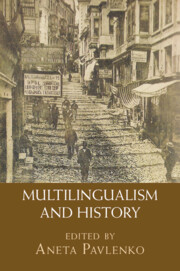Book contents
- Multilingualism and History
- Multilingualism and History
- Copyright page
- Contents
- Figures
- Contributors
- Acknowledgments
- 1 Multilingualism and Historical Amnesia: An Introduction
- 2 Greek Meets Egyptian at the Temple Gate: Bilingual Papyri from Hellenistic and Roman Egypt (Third Century BCE–Fourth Century CE)
- 3 Language Shift, Attitudes and Management in the Roman West
- 4 Languages at War: Military Interpreters in Antiquity and the Modern World
- 5 How Multilingualism Came to Be Ignored in the History of Standard English
- 6 Multilingualism and the Attitude toward French in the Latin Kingdom of Jerusalem
- 7 Why Colonial Dutch Failed to Become a Global Lingua Franca
- 8 How Unique Was Russia’s Multilingual Elite?
- 9 Language Ideology and Observation: Nineteenth-Century Scholars in Northwestern Siberia
- 10 Studying Historical Multilingualism in Everyday Life: The Case of the Habsburg Monarchy in the Nineteenth Century
- 11 Multilingualism and the End of the Ottoman Empire: Language, Script, and the Quest for the ‘Modern’
- 12 “Multilingualism Is Now a Must”: Discourses on Languages and International Cooperation at the Council of Europe
- 13 The Role of the Past in Language Revitalization
- 14 Historic Reenactments in Contemporary Spain: Fiestas de moros y cristianos
- 15 Multilingual Ghost Signs: Dissonant Languages in the Landscape of Memory
- Index
- References
11 - Multilingualism and the End of the Ottoman Empire: Language, Script, and the Quest for the ‘Modern’
Published online by Cambridge University Press: 20 April 2023
- Multilingualism and History
- Multilingualism and History
- Copyright page
- Contents
- Figures
- Contributors
- Acknowledgments
- 1 Multilingualism and Historical Amnesia: An Introduction
- 2 Greek Meets Egyptian at the Temple Gate: Bilingual Papyri from Hellenistic and Roman Egypt (Third Century BCE–Fourth Century CE)
- 3 Language Shift, Attitudes and Management in the Roman West
- 4 Languages at War: Military Interpreters in Antiquity and the Modern World
- 5 How Multilingualism Came to Be Ignored in the History of Standard English
- 6 Multilingualism and the Attitude toward French in the Latin Kingdom of Jerusalem
- 7 Why Colonial Dutch Failed to Become a Global Lingua Franca
- 8 How Unique Was Russia’s Multilingual Elite?
- 9 Language Ideology and Observation: Nineteenth-Century Scholars in Northwestern Siberia
- 10 Studying Historical Multilingualism in Everyday Life: The Case of the Habsburg Monarchy in the Nineteenth Century
- 11 Multilingualism and the End of the Ottoman Empire: Language, Script, and the Quest for the ‘Modern’
- 12 “Multilingualism Is Now a Must”: Discourses on Languages and International Cooperation at the Council of Europe
- 13 The Role of the Past in Language Revitalization
- 14 Historic Reenactments in Contemporary Spain: Fiestas de moros y cristianos
- 15 Multilingual Ghost Signs: Dissonant Languages in the Landscape of Memory
- Index
- References
Summary
This chapter addresses the shift from multilingualism to monolingualism associated with the demise of the Ottoman Empire. It begins with a general overview of the linguistic conditions in the Ottoman lands, briefly surveying the historical dimensions of linguistic interactions reflecting the ebb and flow of Ottoman expansion and contraction, including the Westward movement of Turkic speakers into the central Islamicate lands and Anatolia from the eleventh century, the expansion of Ottoman rule into the Balkans from the fourteenth century, and the influx of Muslim refugees into the shrinking borders of the Empire as a result of military defeats and ethnic cleansing in the nineteenth and early twentieth centuries. The chapter then focuses on three main factors affecting linguistic interactions in the Ottoman lands: (a) the inherently multilingual nature of Ottoman Turkish as an amalgam of three languages, namely, Turkish, Arabic, and Persian; (b) the lived linguistic experience in the Empire, including the lack of a clear correlation between ethnicity, religion, and mother tongue, e.g., large numbers of Armenians, Turks, and Greeks, whose first language was not, respectively, Armenian, Turkish, or Greek, and; (c) the ways in which the advent of nationalism and Western influence affected the linguistic scene in such a diverse and demographically mixed Empire. The chapter ends by considering post-Ottoman language policies and the monolingual orientation of the modern nation-state. The tensions between the two are often revealed when signs of the multilingual past emerge to disturb the monolingual assumptions of the modern, read “national,” era.
Keywords
- Type
- Chapter
- Information
- Multilingualism and History , pp. 205 - 222Publisher: Cambridge University PressPrint publication year: 2023
References
- 1
- Cited by

